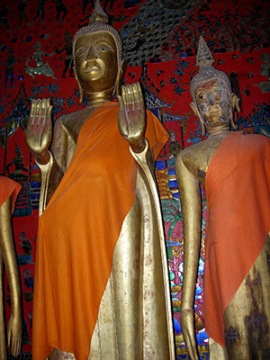
The Buddhist monk’s robe—because one is wearing it — is for mindfulness.
I could see it in terms of attachment. In fact, I have been attached to robes and things like this. But the point of these things is to reflect and remind yourself of what you are doing. When I look at my robe of saffron or orange — a colour that people would seldom wear — it impinges on my consciousness and reminds me of Buddhist monks, which in turn reminds me of sangha [Community of Buddhist monks or those on the path], which is also a reminder of wakefulness. In the same way, how can the Amaravati temple be used? We can look at it aesthetically, in worldly, practical, utilitarian, terms, or we can use it as a symbol. There are Buddha-relics enshrined in the pinnacle of the spire — I enshrined them myself. So you can look up at the pinnacle, and you can look beyond it into the sky, into the spaciousness. Our consciousness can be attuned to infinity and space, and not bound by the five khandhas [Form, feeling, perception, mental activity, and consciousness] and conditioned realm. These kinds of symbols, forms and conventions can be used for awareness rather than for developing worldly attitudes or attachments to becoming some kind of Buddhist. They can be used as forms which says: Wake up! Pay attention! Be mindful!
When you see a Buddhist monk or nun, you may say, ‘Oh, that’s Sister So-and-so,’ or, ‘That’s Venerable So-and-so.’ And because of personalities you say, ‘Sister So-and-so is like this, Venerable So-and-so is like that.’ Or ‘This one I really like; he’s got a great personality. But I don’t really care much for him; he doesn’t do much for me.’ That is seeing it in terms of personality. On the other hand, the form can be seen in terms of awakening — the shaven head, the robe, can be reminders of awareness.
No comments:
Post a Comment